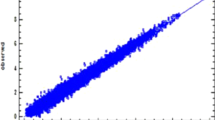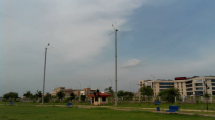Abstract
The objective of the present study is to identify the suitable variables for accurate wind speed prediction using Multi-Layer Perceptron Neural Network (MLPNN) model. To achieve this, monthly data consisting of average temperature, relative humidity, surface pressure, solar radiation, and wind speed were collected from meteorological services for different locations. In this study, 30 models are developed to find the relevant parameters. The results demonstrated that Model#30 and Model#25 with the combination of [Lat, Long, Alt, M, P, T, RH, GSR] and [Lat, Long, Alt, T, RH, GSR] give the best performance compared to the other models. Consequently, the geographical coordinates, temperature, relative humidity, and solar radiation are considered the most relevant that affect wind speed reduction.
Access this chapter
Tax calculation will be finalised at checkout
Purchases are for personal use only
Similar content being viewed by others
References
Santos, F.D., Ferreira, P.L., Pedersen, J.S.T.: The climate change challenge: a review of the barriers and solutions to deliver a Paris solution. Climate 10(5), 75 (2022). https://doi.org/10.3390/cli10050075
Kassem, Y.: Computational study on vertical axis wind turbine car: static study. Model. Earth Syst. Environ. 4(3), 1041–1057 (2018). https://doi.org/10.1007/s40808-018-0461-x
Çamur, H., Kassem, Y., Alessi, E.: A techno-economic comparative study of a grid-connected residential rooftop PV panel: the case study of Nahr El-Bared, Lebanon. Eng. Technol. Appl. Sci. Res. 11(2), 6956–6964 (2021). https://doi.org/10.48084/etasr.4078
Wiser, R., et al.: Expert elicitation survey predicts 37% to 49% declines in wind energy costs by 2050. Nat. Energy 6(5), 555–565 (2021). https://doi.org/10.1038/s41560-021-00810-z
Kassem, Y., Gökçekuş, H., Çamur, H.: Effects of climate characteristics on wind power potential and economic evaluation in Salamis region, Northern Cyprus. Int. J. Appl. Environ. Sci. 13(3), 287–307 (2018)
Khan, M.A., Çamur, H., Kassem, Y.: Modeling predictive assessment of wind energy potential as a power generation sources at some selected locations in Pakistan. Model Earth Syst. Environ. 5, 555–569 (2019). https://doi.org/10.1007/s40808-018-0546-6
Ulazia, A., Sáenz, J., Ibarra-Berastegi, G., González-Rojí, S.J., Carreno-Madinabeitia, S.: Global estimations of wind energy potential considering seasonal air density changes. Energy 187, 115938 (2019). https://doi.org/10.1016/j.energy.2019.115938
Ding, L., Bai, Y., Liu, M.D., Fan, M.H., Yang, J.: Predicting short wind speed with a hybrid model based on a piecewise error correction method and Elman neural network. Energy 244, 122630 (2022). https://doi.org/10.1016/j.energy.2021.122630
Kassem, Y., Gökçekuş, H., Çamur, H.: Analysis of prediction models for wind power density, case study: Ercan area, Northern Cyprus. In: Aliev, R.A., Kacprzyk, J., Pedrycz, W., Jamshidi, M., Sadikoglu, F.M. (eds.) ICAFS 2018. AISC, vol. 896, pp. 99–106. Springer, Cham (2019). https://doi.org/10.1007/978-3-030-04164-9_16
Malik, P., Gehlot, A., Singh, R., Gupta, L.R., Thakur, A.K.: A review on ANN based model for solar radiation and wind speed prediction with real-time data. Arch Comput. Methods Eng. 1–19 (2022). https://doi.org/10.1007/s11831-021-09687-3
Xu, Y., Li, F., Asgari, A.: Prediction and optimization of heating and cooling loads in a residential building based on multi-layer perceptron neural network and different optimization algorithms. Energy 240, 122692 (2022)
Kavzoglu, T., Mather, P.M.: The use of backpropagating artificial neural networks in land cover classification. Int. J. Remote Sens. 24(23), 4907–4938 (2003). https://doi.org/10.1016/j.energy.2021.122692
Chen, J.C., Wang, Y.M.: Comparing activation functions in modeling shoreline variation using multilayer perceptron neural network. Water 12(5), 1281 (2020). https://doi.org/10.3390/w12051281
Danook, S.H., Jassim, K.J., Hussein, A.M.: The impact of humidity on the performance of wind turbine. Case Stud. Thermal Eng. 14, 100456 (2019). https://doi.org/10.1016/j.csite.2019.100456
Yue, W., Xue, Y., Liu, Y.: High humidity aerodynamic effects study on offshore wind turbine airfoil/blade performance through CFD analysis. Int. J. Rotat. Mach. 2017 (2017). https://doi.org/10.1155/2017/7570519
Kassem, Y., Gökçekuş, H., Janbein, W.: Predictive model and assessment of the potential for wind and solar power in Rayak region, Lebanon. Model. Earth Syst. Environ. 7(3), 1475–1502 (2021). https://doi.org/10.1007/s40808-020-00866-y
Author information
Authors and Affiliations
Corresponding author
Editor information
Editors and Affiliations
Rights and permissions
Copyright information
© 2024 The Author(s), under exclusive license to Springer Nature Switzerland AG
About this paper
Cite this paper
Kassem, Y., Gökçekuş, H., Babangida, A., Gumel, A.A. (2024). Applying Multi-layer Perceptron Neural Network to Predict Wind Speed in Lebanon. In: Aliev, R.A., et al. 12th World Conference “Intelligent System for Industrial Automation” (WCIS-2022). WCIS 2022. Lecture Notes in Networks and Systems, vol 718. Springer, Cham. https://doi.org/10.1007/978-3-031-51521-7_33
Download citation
DOI: https://doi.org/10.1007/978-3-031-51521-7_33
Published:
Publisher Name: Springer, Cham
Print ISBN: 978-3-031-51520-0
Online ISBN: 978-3-031-51521-7
eBook Packages: Intelligent Technologies and RoboticsIntelligent Technologies and Robotics (R0)




